
[ Red Cross - Local Activities ] [ Red Cross - Local Volunteers ] [ Red Cross - Local Officers & Committees ] [ Red Cross - National Volunteers ]
No civilian activity of the great world war aroused so entirely the popular interest and made a so direct, human appeal to the great mass of people in Knoxville and Knox County -- irrespective of creed, color, or station in life -- as the Red Cross. Its international emblem, the symbol of mercy, justice and humanity, evoked an overwhelming response whenever a call was made in its behalf. People literally asked to contribute to its cause with their money or to give their time and labor for its sake. Its motives were so high and so pure that no one ever questioned what became of the wealth that was poured out to relieve the sufferings of a war-torn and grief-stricken world.
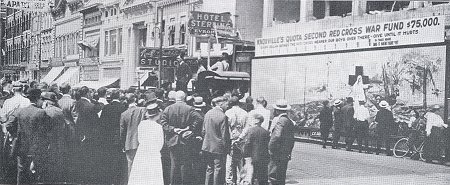 Never an appeal of any kind
for assistance was made that it was not more than answered. If workers
were needed, there were more than there was physical room in which they
could labor comfortably. If contributions of money for the support
of the national and local chapter were necessary, they were far beyond
what was asked. In the first campaign, Knox County was asked to
raise $75,000 as its quota. The contributions were $95,000. In
the second campaign, in which an equal amount was asked, the subscriptions
were $80,000 within three hours after the campaign had started. They
reached approximately $125,000 before the avalanche of gifts stopped.
In the photo at left, Rev. Roy E. Vale speaks to
the crowd on Gay Street during the fund-raising drive, which lasted just
six hours.
Never an appeal of any kind
for assistance was made that it was not more than answered. If workers
were needed, there were more than there was physical room in which they
could labor comfortably. If contributions of money for the support
of the national and local chapter were necessary, they were far beyond
what was asked. In the first campaign, Knox County was asked to
raise $75,000 as its quota. The contributions were $95,000. In
the second campaign, in which an equal amount was asked, the subscriptions
were $80,000 within three hours after the campaign had started. They
reached approximately $125,000 before the avalanche of gifts stopped.
In the photo at left, Rev. Roy E. Vale speaks to
the crowd on Gay Street during the fund-raising drive, which lasted just
six hours.
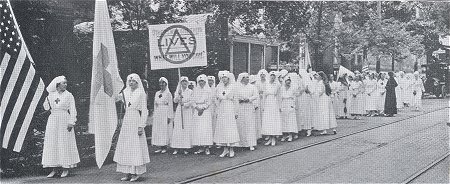 [Photo
at right - Members of the Knox County Chapter assembling for a parade
on Gay Street in one of the campaign drives.]
But great as were the donations of money to the Red Cross by Knox
County -- more than $200,000 was collected in the two campaigns -- the
hundreds of thousands of hours of unselfish, loving work were infinitely
greater. Of the more than 16,000 members in the county, over 6,000
were engaged actively in Red Cross work. Ninety-six women and men
were awarded badges for doing 800 hours of work, twenty-six women received
them for 1,600 hours of labor, while eleven women gave 2,400 hours each
of their time and strength in the interest of the work. These figures
do not take into account the thousands of women and girls who did less
than these amounts, either in the privacy of their homes during leisure
moments or in the regularly organized work rooms of the Red Cross chapter.
[Photo
at right - Members of the Knox County Chapter assembling for a parade
on Gay Street in one of the campaign drives.]
But great as were the donations of money to the Red Cross by Knox
County -- more than $200,000 was collected in the two campaigns -- the
hundreds of thousands of hours of unselfish, loving work were infinitely
greater. Of the more than 16,000 members in the county, over 6,000
were engaged actively in Red Cross work. Ninety-six women and men
were awarded badges for doing 800 hours of work, twenty-six women received
them for 1,600 hours of labor, while eleven women gave 2,400 hours each
of their time and strength in the interest of the work. These figures
do not take into account the thousands of women and girls who did less
than these amounts, either in the privacy of their homes during leisure
moments or in the regularly organized work rooms of the Red Cross chapter.
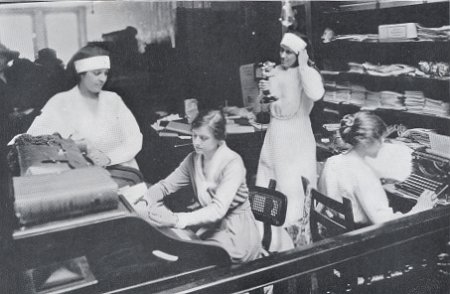 [Photo
at left - "Red Cross Headquarters, Knoxville: Executive office
from which work was directed. Mrs. Ernest Logan, director of woman's
department, is seated at desk."] An insight into the
magnitude of the work accomplished by the Knoxville chapter, its branch
chapter in St. John's Episcopal Church, and its three score auxiliaries,
is given in the final report to the southern division headquarters of
the national organization. From the incorporation of the chapter
on February 7, 1917, until April 30, 1919, the sum of $88,541.82 was collected
for local use, while $77,748.05 of this amount was disbursed for materials
and other necessary expenses. In the surgical dressing department,
607,368 articles were made at a cost of $8,282.20. The garment department
turned out 30,238 articles at an approximate cost of $17,500. The
knitting department made 25,703 articles at a cost of $12,572.98. The
St. John's branch made 54,654 compresses, 16,876 pleated bandages, 1,000
hospital garments, and knitted 447 pairs of socks and 155 sweaters. The
civilian relief department gave assistance to 3,128 families by means
of loans, visits, medical attention, legal advice, and correspondence
in regard to allotments, allowances, and insurance. The loans amounted
to $4,579.71, of which $2,396.07 was repaid by those to whom they had
been made.
[Photo
at left - "Red Cross Headquarters, Knoxville: Executive office
from which work was directed. Mrs. Ernest Logan, director of woman's
department, is seated at desk."] An insight into the
magnitude of the work accomplished by the Knoxville chapter, its branch
chapter in St. John's Episcopal Church, and its three score auxiliaries,
is given in the final report to the southern division headquarters of
the national organization. From the incorporation of the chapter
on February 7, 1917, until April 30, 1919, the sum of $88,541.82 was collected
for local use, while $77,748.05 of this amount was disbursed for materials
and other necessary expenses. In the surgical dressing department,
607,368 articles were made at a cost of $8,282.20. The garment department
turned out 30,238 articles at an approximate cost of $17,500. The
knitting department made 25,703 articles at a cost of $12,572.98. The
St. John's branch made 54,654 compresses, 16,876 pleated bandages, 1,000
hospital garments, and knitted 447 pairs of socks and 155 sweaters. The
civilian relief department gave assistance to 3,128 families by means
of loans, visits, medical attention, legal advice, and correspondence
in regard to allotments, allowances, and insurance. The loans amounted
to $4,579.71, of which $2,396.07 was repaid by those to whom they had
been made.
Mrs. N. E. Logan was the first director general of woman's work in the Red Cross chapter. She served until May 1, 1918, when she went to France in the canteen service. She was succeeded by Mrs. J. Stewart French, who served until the active work closed. There were eight departments into which this work was divided -- surgical dressings, garments, knitting, military relief, civilian relief, education, canteen, and junior departments.
The surgical dressing department started in humble quarters in the rear of the Board of Commerce. Mrs. Charles Huff Davis was supervisor, with Mrs. Benjamin D. Bosworth as assistant. A second move was necessary in the interest of more room, while a third one was made into the "war quarters" in Market Hall, where there were accommodations for 300 women to work at one time. The making of dressings was carried on both day and night.
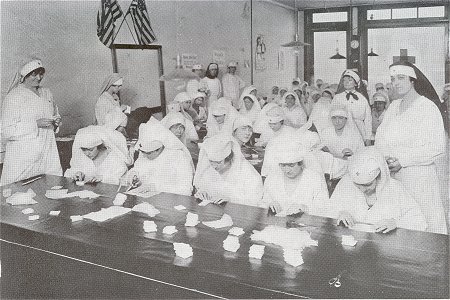 |
| Surgical
Dressings Department Above: Cutting surgical dressings - one of the several departments of women's work in the Knox County Chapter. Below: Red Cross members, working at headquarters under their supervisor, Mrs. Chas. Huff Davis, who is standing at the right. |
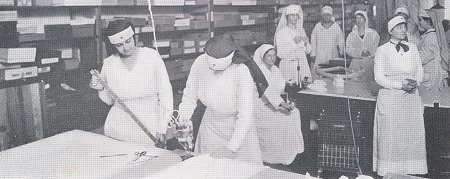 |
Mrs. A. J. Albers was the first superintendent of the garment department, but she was succeeded by Mrs. W. A. McBath, who gave almost a year of her time to the work. This was one of the most interesting of the departments, for the garments were cut from the raw cloth by an electric cutter, operated solely by women, sewed, inspected and packed, ready for shipment to foreign hospitals. They turned out the finished product, ready for a patient to put on.
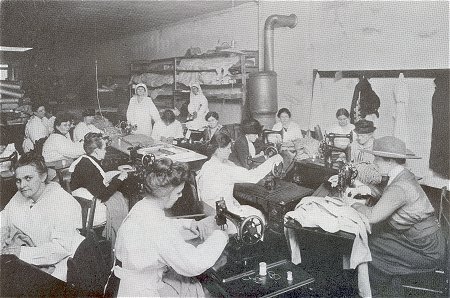 |
| Garment Department Mrs. W. A. McBath, supervisor of this work, and her assistants stitching and sewing at Red Cross headquarters. |
The knitting department had an humble origin, starting in a small room in the Lyceum building. From that it grew to large proportions under the supervision of Mrs. Walter McCoy. Nearly all of the work was done in individual homes, hundreds of women taking home skeins of yarn and knitting gloves, sweaters and socks in odd moments when there were no other duties. The total of their labors was more than 25,000 finished articles.
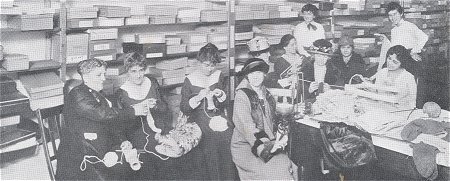 |
| Knitting Department This branch of the Red Cross Chapter, under Mrs. Walter McCoy, as supervisor, did splendid work. |
The civilian relief department met a great need in attendance to the want and welfare of those who had relatives in some branch of federal service. More than 3,000 families, many of them needy, were assisted regularly from June 1, 1917, to May 1, 1919. Service rendered to these families included financial relief, visits to homes for various purposes, medical attention, legal advice, and correspondence regarding allotments, allowances, and insurance. The record committee instructed 800 drafted men in filling out allotment and allowance blanks. Loans of about $4,500 were made to needy families, of which $2,400 afterward was collected. Mrs. Albert G. Hope was chairman of this department until January, 1918, when she was succeeded by Mrs. J. Walter Wright.
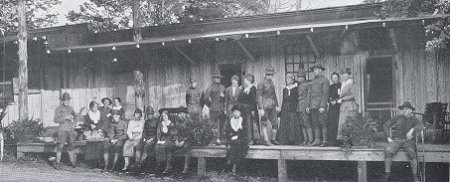 [Photo
at right - "S. A. T. C. Welfare House: Maintained at Chilhowee
Park for troops camped there."] The
military relief committee, with Richard K. Gibson as
chairman, gave its assistance to those in the service who were in need
of help. Before the local guardsmen went to Camp Sevier, they were
supplied with necessary clothing and medical supplies. After they
arrived in camp, the committee continued its supervision of them by importuning
the government for heavier and warmer clothing during the severe winter.
Working in connection with the canteen, a relief booth was installed
at the Southern depot where soldiers' packages were looked after, tickets
exchanged, the sick and needy helped, and meals and lodging furnished.
Loans were made to many soldiers who were temporarily short of funds.
During the influenza epidemic, medicine, supplies and clothing were
furnished to the troops encamped at the University of Tennessee and at
Chilhowee Park. Soldiers in hospitals were visited and relatives
informed of their health.
[Photo
at right - "S. A. T. C. Welfare House: Maintained at Chilhowee
Park for troops camped there."] The
military relief committee, with Richard K. Gibson as
chairman, gave its assistance to those in the service who were in need
of help. Before the local guardsmen went to Camp Sevier, they were
supplied with necessary clothing and medical supplies. After they
arrived in camp, the committee continued its supervision of them by importuning
the government for heavier and warmer clothing during the severe winter.
Working in connection with the canteen, a relief booth was installed
at the Southern depot where soldiers' packages were looked after, tickets
exchanged, the sick and needy helped, and meals and lodging furnished.
Loans were made to many soldiers who were temporarily short of funds.
During the influenza epidemic, medicine, supplies and clothing were
furnished to the troops encamped at the University of Tennessee and at
Chilhowee Park. Soldiers in hospitals were visited and relatives
informed of their health.
The Junior Red Cross, organized early in 1918, grew into large proportions and did splendid work. Thirty-one auxiliaries were organized with a total membership of about 12,000. These were principally in the city and county schools. More than $3,000 was raised and disbursed by the children in their work. Sixty French war orphans were adopted and provided for during a period of two years. In the manual training departments of the schools, the boys and girls made packing boxes for surgical dressings, applicator sticks for use in surgical packets, and other useful articles. The girls knitted sweaters, wristlets, and quilt squares. A total of 106,027 articles was turned out by members of the Junior Red Cross.
No branch of the Red Cross Chapter was more popular or filled a more direct need than the canteen at the railroad station, organized early in 1918 by Mrs. A. F. Sanford, and conducted later under the direction of Mrs. E. E. Norris and Mrs. E. C. Gothard. Between 300,000 and 400,000 troops, which passed through Knoxville enroute to camps or returning home to hospitals from the battle field, were served by the canteen. Regular shifts of workers stayed on duty seven days in the week from six o'clock in the morning until eleven o'clock at night. No matter what kind of weather or what the hour, every train was met and refreshment offered to all men in uniform. During the months the canteen was in operation, the sum of $11,927.91 was expended in buying supplies and equipment. An appropriation of $2,500 was made by the Red Cross chapter, but the rest was contributed by patriotic citizens.
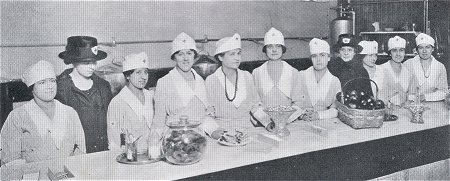 |
| The Canteen Counter Across this counter in the Southern station, thousands of men in service were fed by the women of the Knoxville Red Cross. |
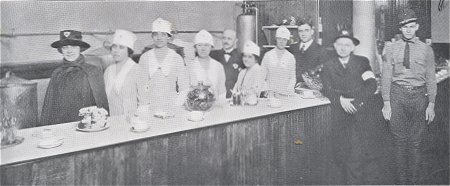 |
| On Duty at the Canteen Taking their turn at serving the soldiers at one of the canteen counters. |
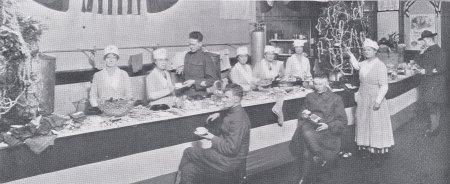 |
| Christmas at the Canteen The decorations and good things to eat made it a joyous season for weary soldiers. |
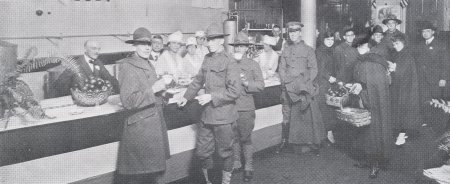 |
| Day and Night Nothing at the Canteen was too god for men in uniform, and they were given a smile with it. |
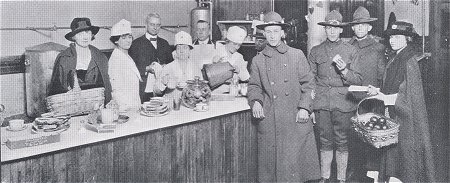 |
| Doughnuts Here Too The Red Cross Canteen served them in Knoxville like the Salvation Army did in France. |
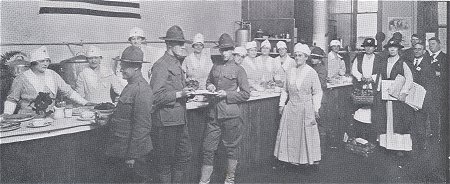 |
| A
Feast for a King The loaded counter shows no soldiers went hungry from the Red Cross Canteen. |
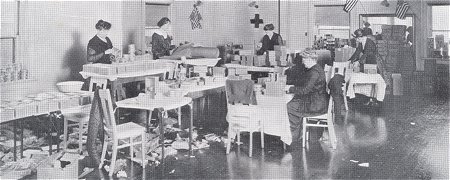 |
| Making
Christmas Packages Red Cross members preparing boxes to be sent away to soldiers at the camps and in the trenches. |
However, the donations of money were a tiny mite compared to the value of gifts of food made by housewives of the city and county and by the wholesale fruit houses. Jellies, preserves, sandwiches, pastries, fruits, and all kinds of delicacies were contributed in season and out of season by those who wished to do "their bit" in this way. No man in uniform was ever allowed to pass through the railroad station without a uniformed worker offering him cigarettes, coffee, pies, or any other delicacy that was in stock at the time. It made no matter whether he was a Tennessean or a native of another state. The uniform was the "open sesame" for a shower of attention by the canteen workers.
This personal attention, this kindness and untiring attention, this cordiality shown to all alike made the canteen a mighty instrument in maintaining a high morale among the troops, as well as ministering to their material needs. Often a home-sick and discouraged soldier, far away from home and loved ones, poured out his woes into the sympathetic ear of some canteen worker, who gave him encouragement and sent him smiling on his way.
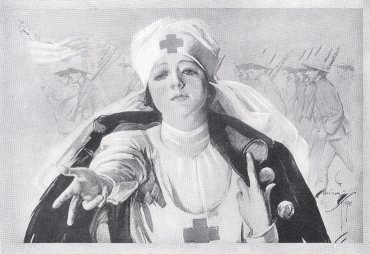 In
addition to these kindly services, first aid was rendered to 370 soldiers,
87 were taken from trains to hospitals, guides were furnished for detachments
which had a few hours between trains and which wished to take walks over
the city, telegrams were sent to relatives, more than 1,000 conducted
to the Y. M. C. A. for baths and swims, while hundreds of thousands of
post cards were given to men on which to write home.
In
addition to these kindly services, first aid was rendered to 370 soldiers,
87 were taken from trains to hospitals, guides were furnished for detachments
which had a few hours between trains and which wished to take walks over
the city, telegrams were sent to relatives, more than 1,000 conducted
to the Y. M. C. A. for baths and swims, while hundreds of thousands of
post cards were given to men on which to write home.
Ossoli Circle, shortly after war was declared, took up the making of hospital garments among its membership. This work was thoroughly organized, perfected and continued until the last days of 1917, when it was merged with the central garment makers' department of the Red Cross. The circle thereafter devoted its time to other war work. Its most notable achievement, however, was the formation of 35 auxiliaries among the churches of the city and county, and among the county seats of the surrounding counties.
The only auxiliary of the Knoxville chapter that grew to the proportion of being raised to a branch in rank was the one organized in August, 1917, among the membership of St. John's Episcopal Church. The auxiliary started and kept through to its end the same board of officers. They were Dr. Walter C. Whitaker, president; R. K. Gibson, chairman of finance; Fritz Staub, chairman of relief work; D. M. Chambliss, chairman of supplies; George F. Harrison, secretary and treasurer. From August until November, 1917, the sewing rooms in the Lyceum building were used, but thereafter the auditorium of the parish house was converted into a work room in which bandages and surgical dressings were made. On April 1, 1918, in recognition of its fine work, the St. John's auxiliary became the St. John's branch of the Knoxville chapter. It was entirely self-supporting and did all kinds of Red Cross work. During the twelve months of active operation, the following articles were turned out by the women of this branch: 54,654 compresses, 16,876 plaited bandages, 1,000 hospital garments, 587 pads and belts, 60 sweaters, 38 sponges, 12 bathrobes, 447 pairs of socks, and 155 sweaters. This made a total of approximately 75,000 articles. Many of the officers and instructors in the parent chapter came from St. John's Church.
In conclusion, it should be noticed that the Knoxville chapter of the Red Cross was in the field and working before war was declared on April 6, 1917. Due to the efforts principally of Mrs. N. E. Logan, an organization had been perfected two months earlier, on February 6, and therefore work was well under way when the formal declaration came.
[ Return to Knox County Genealogy Military Page ]
[ Return to Knox County Genealogy Main Page ]
Except as noted, all HTML code and graphics in the URL path [http://www.knoxcotn.org/military/wwi/] were created by and copyrighted 2001-2003 to Billie R. McNamara. All rights reserved. Please direct all questions and comments to Ms. McNamara.This page was last updated January 2, 2004. Visitor